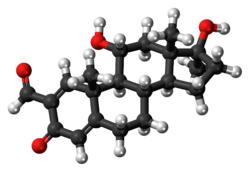Formebolone
Formebolone (INN, BAN) (tên thương hiệu Esiclene, Hubernol, Metanor), còn được gọi là (một cách khó hiểu) là formyldienolone, cũng như 2-formyl-11α-hydroxy-17α-methyl-δ1-testosterone, là một hoạt chất đường uống. steroid androgenic (AAS) được mô tả như một anticatabolic và anabolic thuốc đó đã hoặc đang bán trên thị trường ở Tây Ban Nha và Ý.[1][2][3] Là một AAS, nó cho thấy một số hoạt động đồng hóa, mặc dù nó kém hơn testosterone về tiềm năng, nhưng được cho là hầu như không có hoạt động androgen.[4] Formebolone chống lại tác dụng dị hóa (kiểm soát cân bằng nitơ) của glucocorticoids mạnh như dexamethasone phosphate.[4][5] Một chất tương tự gần gũi, roxibolone (và biến thể ester decylroxibolone tác dụng dài của nó), cho thấy hoạt động tương tự antiglucocorticoid với formebolone, nhưng ngược lại, không có hoạt tính như AAS.[6]
 | |
 | |
| Dữ liệu lâm sàng | |
|---|---|
| Tên thương mại | Esiclene, Hubernol, Metanor |
| Đồng nghĩa | Formyldienolone; 2-Formyl-11α-hydroxy-17α-methyl-δ1-testosterone |
| Dược đồ sử dụng | Oral |
| Các định danh | |
Tên IUPAC
| |
| Số đăng ký CAS | |
| PubChem CID | |
| ChemSpider | |
| Định danh thành phần duy nhất | |
| ChEMBL | |
| ECHA InfoCard | 100.017.749 |
| Dữ liệu hóa lý | |
| Công thức hóa học | C21H28O4 |
| Khối lượng phân tử | 344.44 g/mol |
| Mẫu 3D (Jmol) | |
SMILES
| |
Định danh hóa học quốc tế
| |
| (kiểm chứng) | |
Roxibolone đã được tìm thấy không liên kết với thụ thể glucocorticoid, và người ta đã đề xuất rằng hoạt động antiglucocorticoid của roxibolone và formebolone có thể được điều hòa bằng cách điều chế các quá trình enzyme.[7] Thật vậy, 11α- và 11β-hydroxyprogesterone (formebolone và roxibolone là 11α- và 11β-hydroxylated (tương ứng) tương tự) được biết đến là chất ức chế mạnh của 11β-hydroxapseoid dehydrogenase (11β-HSD), chịu trách nhiệm cho quá trình sinh tổng hợp. glucocorticoids nội sinh cortisol và corticosterone (từ tiền chất deoxycortisol và deoxycorticosterone, tương ứng).[8][9] Tuy nhiên, formebolone được phát hiện là chất ức chế rất yếu của 11β-HSD loại 2 (IC<sub id="mwRQ">50</sub> > 10 M), mặc dù isoenzyme đặc biệt này của 11β-HSD chịu trách nhiệm cho việc bất hoạt glucocorticoids thay vì sản xuất.[10]
Tham khảo sửa
- ^ Index Nominum 2000: International Drug Directory. Taylor & Francis. tháng 1 năm 2000. tr. 471–. ISBN 978-3-88763-075-1.
- ^ J. Elks (14 tháng 11 năm 2014). The Dictionary of Drugs: Chemical Data: Chemical Data, Structures and Bibliographies. Springer. tr. 577–. ISBN 978-1-4757-2085-3.
- ^ I.K. Morton; Judith M. Hall (31 tháng 10 năm 1999). Concise Dictionary of Pharmacological Agents: Properties and Synonyms. Springer Science & Business Media. tr. 125–. ISBN 978-0-7514-0499-9.
- ^ a b Gelli D, Vignati E (1976). “Metabolic studies with formebolone (2-formyl-17 (alpha)-methyl-androsta-1,4-diene-11 (alpha), 17 (beta)-diol-3-one) in humans”. J. Int. Med. Res. 4 (2): 96–105. doi:10.1177/030006057600400203. PMID 799985.
- ^ Cerutti S, Forlani A, Galimberti E (1976). “Anticatabolic action of formebolone in the castrated rat treated with dexamethasone”. Arzneimittelforschung. 26 (9): 1673–7. PMID 1036699.
- ^ Felippone F, Resnati G, Scolastico C, Tronconi G (1984). “Synthesis of 2-carboxy-11 beta, 17 beta-dihydroxy-17-methyl-1, 4-androstadien-3-one and related compounds”. Steroids. 43 (3): 271–82. doi:10.1016/0039-128x(84)90045-x. PMID 6523544.
- ^ Dahlberg E, Snochowski M, Gustafsson JA (1981). “Regulation of the androgen and glucocorticoid receptors in rat and mouse skeletal muscle cytosol”. Endocrinology. 108 (4): 1431–40. doi:10.1210/endo-108-4-1431. PMID 6970661.
- ^ Souness GW, Latif SA, Laurenzo JL, Morris DJ (1995). “11 alpha- and 11 beta-hydroxyprogesterone, potent inhibitors of 11 beta-hydroxysteroid dehydrogenase (isoforms 1 and 2), confer marked mineralocorticoid activity on corticosterone in the ADX rat”. Endocrinology. 136 (4): 1809–12. doi:10.1210/endo.136.4.7895695. PMID 7895695.
- ^ Souness GW, Morris DJ (1996). “11 alpha- and 11 beta-hydroxyprogesterone, potent inhibitors of 11 beta-hydroxysteroid dehydrogenase, possess hypertensinogenic activity in the rat”. Hypertension. 27 (3 Pt 1): 421–5. doi:10.1161/01.hyp.27.3.421. PMID 8698448.
- ^ Fürstenberger C, Vuorinen A, Da Cunha T, Kratschmar DV, Saugy M, Schuster D, Odermatt A (2012). “The anabolic androgenic steroid fluoxymesterone inhibits 11β-hydroxysteroid dehydrogenase 2-dependent glucocorticoid inactivation”. Toxicol. Sci. 126 (2): 353–61. doi:10.1093/toxsci/kfs022. PMID 22273746.